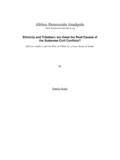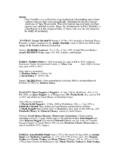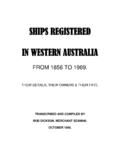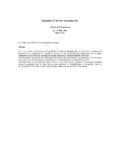Transcription of GLOBAL FOREST PRODUCTS FACTS AND FIGURES …
1 GLOBAL FOREST PRODUCTS FACTS AND FIGURES2016 PAPER AND PAPERBOARDFIBRE FURNISHWOOD-BASED PANELSSAWNWOODINDUSTRIAL ROUNDWOODWOOD FUEL, CHARCOAL AND PELLETS FAO/MASAKAZU KASHIO1 This note presents highlights and recent trends in data for each of the main product groups, as well as a short summary of recent changes or improvements in statistics. Some of the main points are highlighted below. |The continuing recovery from the economic downturn of 2008 2009 is evident in the statistics gathered between 2012 and 2016. Globally, production of all major PRODUCTS (industrial roundwood, sawnwood, wood-based panels, pulp and paper) has shown gradual recovery from 2012. Production in 2016 was higher than in 2015 (and the pre-crisis 2007 level) for all of the product groups (with panels at 4 percent growth, industrial roundwood and sawnwood both at 3 percent, wood pulp at 2 percent and paper at percent). The fastest growth was in Asia-Pacific, Northern America and Europe, likely due to positive economic growth in these regions.
2 |China has grown in importance as both a producer and consumer of FOREST PRODUCTS , and has recently overtaken a number of other big players in different product groups ( Canada in sawnwood production and the United States of America in sawnwood consumption). The country is by far the largest producer and consumer of wood-based panels and paper. It is also highly significant in international trade of FOREST PRODUCTS , being the world s largest importer of industrial roundwood, sawnwood and fibre furnish (pulp and recovered paper), and the largest exporter of wood-based panels. In 2016, China s imports of industrial roundwood increased by 9 percent, while sawnwood, panel and paper production and consumption continued to grow faster than in the rest of the world. |Wood pellets production has increased dramatically in recent years, mainly owing to demand generated from bioenergy targets set by the European Commission. In 2016, GLOBAL production grew by another 6 percent, reaching 29 million tonnes, of which more than half (17 million tonnes) was traded internationally.
3 An increase in the United Kingdom s imports and consumption (by million tonnes) accounted for most of the increase in the GLOBAL consumption and imports. Europe and Northern America accounted for almost all GLOBAL production (58 percent and 32 percent respectively) and consumption (81 percent and 8 percent respectively). |Consumption and imports of wood pellets in Asia increased by 17 percent in 2016. The Republic of Korea became the third largest wood pellets importer (was 4th in 2015), driving up wood pellets production in countries in the region (especially Viet Nam, Malaysia, Indonesia and Thailand). Imports of wood pellets also increased in Japan and China. |Wood-based panel and sawnwood production (combined) grew in all five regions around the world in 2016. GLOBAL production of both panels and sawnwood increased by 3 percent while trade growth accelerated to 7 percent, the fastest growth since 2010. GLOBAL production of panels was record high (416 million m ) and sawnwood registered the highest production since 1989 (468 million m ).
4 |Canada saw double digit growth in production and exports of sawnwood and panels from 2012 to 2016 thanks to increased sales to the United States of America (due to a recovering economy and housing market). |South America has continued expanding wood pulp production with an increasing number of new pulp mills being built in Brazil, Chile and Uruguay. These three countries currently account for 15 percent of GLOBAL wood pulp production and 33 percent of exports. From 2012 Brazil increased exports by 52 percent and overtook Canada for the first time as the world s second largest country in fibre furnish exports in 2016. | GLOBAL production and trade in wood pulp grew by 2 and 5 percent respectively, much faster than recovered paper (1 percent) in 2016. |In 2016, paper production stagnated in Europe but declined in Northern America while it grew modestly in Latin America and the Caribbean and Asia-Pacific. GLOBAL production of graphic papers declined by another 2 percent while other paper and paperboard recorded a healthy 4 percent s FOREST PRODUCTS statistics present FIGURES for the production and trade (quantity and value) of FOREST PRODUCTS , covering 55 product categories, 21 product groups, and 245 countries and territories.
5 Final statistics are released at the end of each year and can be found in the FAOSTAT-Forestry database from December, before they are published in the Yearbook of FOREST PRODUCTS the following April. The database has statistics from 1961 onwards, and the yearbooks date back to FOREST PRODUCTS FACTS AND FIGURES2016 HIGHLIGHTS FROM 2012 2016 GLOBAL FOREST PRODUCTS / FACTS AND FIGURES 20162In 2016, GLOBAL industrial roundwood production amounted to 1 874 million m . This is an increase of percent compared to 2015 (1 826 million m ) and percent compared to the level in 2012 (Figure 1a).Most of the growth occurred in Asia-Pacific, Europe and Northern America, which, in 2016, jointly produced 7 percent more than in 2012. Production in Africa and Latin America and the Caribbean did not change significantly during this 2016, production in each region was as follows: Europe (including the Russian Federation) 590 million m (32 percent); Northern America (USA and Canada) 514 million m (27 percent); Asia and the Pacific 459 million m (24 percent); Latin America and Caribbean 237 million m (13 percent); and Africa 73 million m (4 percent).
6 In 2016, GLOBAL trade in industrial roundwood amounted to 125 million m (equal to about 7 percent of production). Trends in total trade and net trade over the observed period showed an increase of 13 and 5 percent in 2013 and 2014 respectively (Figure 1b), a 9 percent decline in 2015 and a 3 percent increase in 2016. At a regional level, Asia-Pacific was a net importer of industrial roundwood, and all other regions were net exporters. In 2016, net imports of 36 million m accounted for about 7 percent of consumption in the Asia-Pacific region. Europe and Northern America were the main net exporters of industrial roundwood, with net exports in 2016 of 12 million m and 13 million m respectively, similar to the level of the country level, the five largest producers of industrial roundwood are the USA, the Russian Federation, China, Canada and Brazil (Figure 2a). Together, these countries produced 1 022 million m in 2016, or 55 percent of total GLOBAL production.
7 The USA is by far the largest producer in the world (357 million m in 2016); production has been increasing every year since 2012. Production in the Russian Federation and Canada has increased since 2012. Production in China and Brazil declined in 2015 but recovered in with other FOREST PRODUCTS , exports of industrial roundwood are relatively small and only 15-20 countries export more than 1 million m each year. Combined, the five largest exporters accounted for 60 million m3, or 49 percent of all exports. The Russian Federation is the main exporter, although exports increased moderately in recent years. Other major exporters are: New Zealand; United States of America; Canada; and Czechia. Industrial roundwood is all roundwood used for any purpose other than energy. It comprises: pulpwood; sawlogs and veneer logs; and other industrial roundwood ( roundwood used for fence posts and telephone or electricity poles). This product group is also divided into roundwood from coniferous and non-coniferous ROUNDWOODFIGURE 1A.
8 Industrial roundwood production Africa Asia-Pacific Europe Latin America and Caribbean Northern AmericaFIGURE 1B. Industrial roundwood net tradeMillion cubic metresMllion cubic metres FAO/FO-612002004006008001000120014001600 1800200020162015201420132012010203040201 62015201420132012-40-30-20-1002016201520 14201320123 INDUSTRIAL ROUNDWOODE xports from New Zealand, Canada and Czechia increased while those from United States of America decreased in 2016 (Figure 2b).Owing to the relatively small volumes of international trade in industrial roundwood, the five largest producers are also the five largest consumers. China is the second-largest consumer (213 million m of roundwood in 2016), with a 9 percent increase in imports in 2016. The Russian Federation is third (at 178 million m ) (Figure 3a). Since 2012, consumption has increased in all major consumer countries except Brazil where consumption started recovering only in Figure 3b shows, imports make up about 23 percent (49 million m in 2016) of China s industrial roundwood consumption.
9 A large share of these imports come from the Russian Federation, although other countries, especially New Zealand, are growing in importance. After China, other major importers of industrial roundwood are Austria, Germany, Sweden and Finland. Together, these five countries imported 80 million m of industrial roundwood in 2016 (equivalent to 63 percent of all imports). Austria overtook Germany to become the second-largest importer in 2A. Industrial roundwood productionFIGURE 3A. Industrial roundwood consumption Brazil Canada China Russia USA Brazil Canada China Russia USA Canada Czechia New Zealand Russia USA Austria China Finland Germany SwedenFIGURE 2B. Industrial roundwood exportsFIGURE 3B. Industrial roundwood importsMillion cubic metresMillion cubic metresMillion cubic metresMillion cubic metres FAO/FO-7552 FAO/FO-743205010015020025030035040020162 0152014201320120510152025201620152014201 3201205010015020025030035020162015201420 132012010203040506020162015201420132012 GLOBAL FOREST PRODUCTS / FACTS AND FIGURES 20164In 2016, GLOBAL sawnwood production totalled 468 million m , which was percent higher than in 2015 (453 million m ) and 16 percent higher than in 2012 (405 million m ).
10 Figure 4a shows that sawnwood production grew consistently over the 2012 2016 period. This trend is largely due to increasing production in Asia and the Pacific, Europe and Northern America. In contrast, production in Africa and in Latin America and the Caribbean remained modest over the same period. The latest regional production FIGURES for 2016 are as follows: Europe 156 million m (34 percent); Asia and the Pacific 139 million m (30 percent); Northern America 128 million m (27 percent); Latin America and the Caribbean 34 million m (7 percent); and Africa 10 million m (2 percent). GLOBAL trade in sawnwood amounted to 144 million m (equal to 31 percent of production) in 2016 and, like production, has been increasing since 2012. Most of this growth in trade occurred in Northern America, Asia and the Pacific and Europe. Net trade between the five regions increased consistently during the observed period (Figure 4b).

















